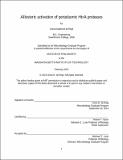Allosteric activation of periplasmic HtrA proteases
Author(s)
De Regt, Anna Katherine
DownloadFull printable version (3.399Mb)
Other Contributors
Massachusetts Institute of Technology. Department of Biology.
Advisor
Robert T. Sauer.
Terms of use
Metadata
Show full item recordAbstract
Escherichia coli responds to outer-membrane stress using a signaling cascade initiated when DegS, an HtrA-family periplasmic protease, cleaves RseA, a transmembrane anti-sigma factor, causing downstream release of the [sgima]E sigma factor and transcription of stress-response genes. Each subunit of the DegS trimer contains a trypsin-like protease domain and a PDZ domain. In the absence of stress, autoinhibitory interactions stabilize an inactive conformation of DegS. Allosteric activation occurs as a consequence of the linked binding of unassembled outer-membrane proteins to the PDZ domains and RseA to the DegS active sites. In Chapter 2, I probe the pathway of communication between the PDZ and protease domains and identify a set of residues crucial for signal propagation across the enzyme. This set of residues is conserved across the HtrA protease family, including orthologs linked to human disease, and thus a common mechanism of allosteric activation appears to function in all family members. No satisfactory mechanism explains how OMP-peptide binding breaks autoinhibitory interactions. In Chapter 3, I present evidence that peptide binding initiates a steric clash between the side chains of a PDZ residue and an L3-loop residue that forces rearrangement of the loop and simultaneously breaks autoinhibitory interactions. In Pseudomonas aeruginosa, a homologous signaling cascade controls the release of the transcription factor AlgU, which directs the production of alginate, an exopolysaccharide that protects the bacterium from antibiotics and the host immune system. The HtrA protease AlgW is activated by misfolded OMPs to cleave its transmembrane substrate MucA. In Chapter 4, I describe a collaboration that identifies the protein CupB5 as a novel regulator of this pathway. Peptides corresponding to a region of CupB5 needed for mucoidy activate AlgW in conjunction with OMPs to stimulate cleavage of MucA in vitro. Finally, in Chapter 5, I summarize my findings on DegS and describe aspects of DegS activation that are yet to be resolved.
Description
Thesis: Ph. D., Massachusetts Institute of Technology, Department of Biology, 2015. This electronic version was submitted by the student author. The certified thesis is available in the Institute Archives and Special Collections. Cataloged from student-submitted PDF version of thesis. Includes bibliographical references.
Date issued
2015Department
Massachusetts Institute of Technology. Department of BiologyPublisher
Massachusetts Institute of Technology
Keywords
Biology.